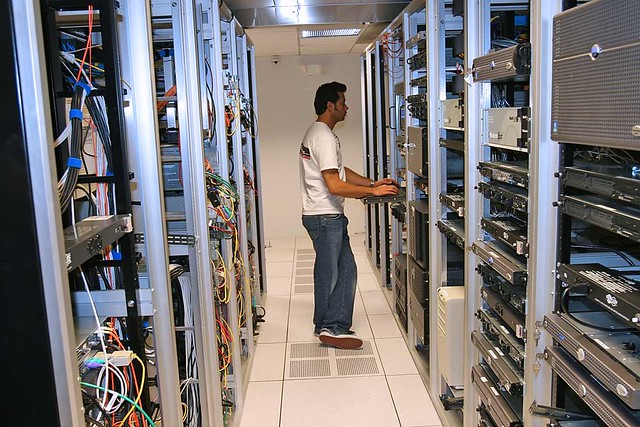
Image Credit: clayirving
You would think that being a CIO these days would be a pretty easy job. All you really have to do is to find ways to move more and more of your company’s IT assets into the cloud and everyone will think that you are doing a great job! However, it turns out that a number of people with the CIO job who understand the importance of information technology are starting to have second thoughts about doing exactly that. It turns out that there are a number of issues such as cost and security that make what seemed like a simple decision a lot harder. CIOs need to take a careful look at their current situation and make the right decisions.
Where’s The Data?
It turns out that unlike what you may have read in various trade publications, currently companies are starting to keep more and more data on premises. This is a shift. This change involves on-premises infrastructure and often some form of private clouds, is hard to ignore. A survey was taken recently that showed that people in the CIO position are expecting on average to keep 52% of their data on premises, up from the previous 48%. Other surveys of European and Asian businesses showed even greater increases in the number of CIOs expecting to keep more than half of their data on premises.
This leads to the question of just exactly what does all of this mean? It turns out that more data being kept on premises means less data being stored in the public cloud. What CIOs need to be aware of is that the U.S. survey has private cloud usage remaining constant, while expected use of public cloud dropping by half and “mixed private/public cloud” increasing by 40%. Another study that has been performed used a worldwide survey of 400 CIOs, showed the same results. On average respondents to the survey were expecting over the next two years to repatriate half of their data off public cloud applications to hosted private or on-premises locations.
The Drivers Are Security, Performance and Costs
As CIOs, when we read about these kinds of changes happening in how people are storing their data, it makes us wonder what is happening? The survey indicated several reasons for the changes. The number one reason for keeping more company data on your premises is due to security concerns. Each public cloud, private cloud, hybrid, mixed and on-premises deployment comes with its own strengths and weakness. What CIOs are discovering is that the security, compliance, and general control available on the public cloud leaves many companies wanting.
What CIOs are starting to see are companies requiring very tight control in multiple verticals. As an example, financial companies are looking for PCI-compliant private clouds to handle card transactions and cardholder data; and healthcare companies are asking for HiTrust-certified private clouds. In the world of IT, HiTrust is common framework that incorporates HIPAA, PCI and other security standards. There has been a reason that CIOs have been moving both applications and data into the public cloud. The feature most valued in the public cloud has been flexibility. Yet the things that were once only found in public clouds such as elastic storage, containerized applications and pay-as-you-go models have now become part of on-premises and private cloud environments. Just because you place your data locally, does not mean that it can’t be accesses by applications running in the public cloud. Bridges between public cloud and enterprise data centers, such as Microsoft’s Azure Stack have made it possible to keep data primarily on premises.
The costs associated with placing a company’s applications in a private cloud continue to decrease. More and more cost is becoming less of a differentiator, especially when you consider long-term, total cost of ownership. A company that runs on applications is going to need to keep data for years. Each case is different, but if the cost advantage of public cloud goes away, if elasticity is not even required, and if security and control remain high priorities, then the private cloud and on-premises options are going to look all the more attractive to CIOs.
What All Of This Means For You
Once upon a time being the CIO was an easy job. All you had to do was to tell everyone to move everything into the cloud and you would look like you were being very progressive. However, over time CIOs have taken a closer look at the public cloud and they have started to compare it to what they can achieve with a private cloud or with a hybrid cloud configuration. For a variety of reasons, including costs and security, private clouds are starting to look like more of an attractive option in comparison to public clouds.
Surveys are starting to show that more than half of the CIOs contacted are planning on keeping their data in private data centers. More data is starting to be kept in private data centers than is being moved to public clouds. Additionally, data that has already been moved into the public cloud is being brought back and will be placed into private cloud configurations. One of the main reasons for keeping company data in a private cloud has to do with security. Public clouds just don’t offer CIOs the security controls that they need in order to feel that their data is secure. Many of the key features that were once only available in the public cloud are now starting to become available in the private cloud also. Going forward, the costs associated with keeping data in a private cloud are dropping and soon there will be virtually no difference based on cost as to where CIOs choose to store their data.
CIOs are now facing a more complex decision that they will have to make. What used to be simple, move everything to the cloud, has now become more challenging as CIOs attempt to determine where the correct location for their valuable company data is. The decreasing costs of private clouds and the greater security controls that they provide are starting to cause CIOs to move more and more of their data into their on-prem private clouds. Every CIO needs to be aware of this trend and make the right decision for their company.
– Dr. Jim Anderson
Blue Elephant Consulting –
Your Source For Real World IT Department Leadership Skills™
Question For You: If you choose to keep your company data in your private cloud, what security precautions will you have to take?
P.S.: Free subscriptions to The Accidental Successful CIO Newsletter are now available. Learn what you need to know to do the job. Subscribe now: Click Here!
What We’ll Be Talking About Next Time
In the post pandemic world CIOs are facing a major challenge: where should everyone work? There are those people who have been just waiting for permission to return to the office because they like the environment and the interaction with all of the different people. However, on the other hand there are the people who actually prefer to work from home and who might leave the company if they were forced to come back into the office. CIOs are going to end up with a hybrid work environment with some workers in the office and some remote. How is this going to work out for everyone?

